ISSN ONLINE(2319-8753)PRINT(2347-6710)
ISSN ONLINE(2319-8753)PRINT(2347-6710)
| Dr. G. T. Sundar Rajan Assistant Professor, EEE Department, Sathyabama University, Chennai, India. |
| Related article at Pubmed, Scholar Google |
Visit for more related articles at International Journal of Innovative Research in Science, Engineering and Technology
This paper focuses on the power quality improvement of three phase diode rectifier for DC drive applications. The input current harmonics distortion (THD), power factor at input side and voltage regulation of the three phase diode rectifier is investigated for power quality improvement. In this method, bidirectional switches are connected across the front end rectifier to improve the conduction of input current in order to improve the Total Harmonic Distortion (THD). The buck regulator is connected at the output stage of three phase diode rectifier for the voltage regulation. The circuit with buck regulator is simulated for different torque conditions of DC motor using PI current controller, Fuzzy Logic Controller (FLC) and Adaptive Neuro-Fuzzy Inference Systems (ANFIS) and the results are compared for the power factor improvement. Design of Fuzzy controller and Adaptive Neuro-Fuzzy Inference Systems (ANFIS) are based on heuristic knowledge converter behavior. The design of PI control is based on the frequency response of the converter. For the DC drive applications, the performance of the Fuzzy controller and Adaptive Neuro-Fuzzy Inference Systems (ANFIS) are superior in some respects to that of the PI controller.
Keywords |
| Three phase diode rectifier, Fuzzy Logic Controller, Adaptive Neuro-Fuzzy Inference system, power factor correction, and DC drives. |
INTRODUCTION |
| HARMONIC current pollution generated by nonlinear loads is a serious problem in power systems. Numerous harmonic standards have been put forward on this issue, for example, IEEE and IEC standards [1]. Since three-phase diode rectifiers are widely used in industry, such as adjustable speed drives and dc power supplies [2]–[4], the harmonics generated by the diode rectifier in the line current is a main concern in power electronics. To eliminate the harmonic current generated by this type of harmonic source, the shunt active power filter (APF) or series APF has been an effective solution [5]–[11]. However, the rating of APF is normally small because of its partial power processing property. Hence, it generally features with low cost and small volume. Shunt APF’s are usually paralleled at the ac side. Therefore, both the voltage and the current processed by APF are with alternating values. |
| A four-quadrant inverter is commonly used in the power stage of the ac side APF, and an ac side APF always needs complicated harmonic current detection and control. On the other hand, the three-phase power factor correction (PFC), which is a full power processing solution, has been extensively studied [12]–[19]. The most popular topology of the three-phase PFC is a six-switch bridge. This type of PFC has the feature of bidirectional power flowing capability. In some specific applications, unidirectional PFC topologies such as the Vienna converter [15], [16] and the series connected dual boost converter [19], [20] are considered. Both bidirectional and unidirectional three-phase PFCs are required to process all the load power. Thus, most of them suffer from higher silicon cost as compared with the APF solutions which require only partial power processing. Multipulse rectifiers, which employ low frequency phase shift transformer to synthesize reasonable line current waveform, are also reported for the reduction of the silicon cost [17], [18]. Due to the application of low frequency transformer, the volume is a critical limitation. Three phase diode rectifier with bidirectional switches and the buck regulator at the output stage is implemented [21]-[25] with DC and AC drive applications. The performance of diode rectifier is verified with only one controller. |
| In this paper, a simple buck regulator at the output stage of three phase diode rectifier with bidirectional switches is proposed. The buck regulator regulates the voltage at the output stage for speed control applications. The Fuzzy Logic based control method and ANFIS are developed to improving the conduction period of the bidirectional switches. The new technique is simulated with DC drive application by PI current controller, Fuzzy Logic Controller and ANFIS and the results are compared. |
ANALYSIS OF PROPOSED DIODE RECTIFIER WITH BUCK REGULATOR |
| The circuit diagram of proposed diode rectifier with buck regulator is shown in Fig. 1. For the circuit analysis, six topological stages are presented in Fig. 2 a to f, corresponding to the 0° to 180° half period. Two main situations can be identified: |
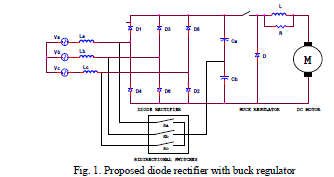 |
| 1. In the stage I, III and V, there are only two conducting diodes. As a result, on a conventional three-phase rectifier, the current on the third phase remains null during that interval. In the circuit, the switch associated with the third phase is gated on during that interval. For instance, during the 0° to 30° stage, the bidirectional switch is gated on, so the input current evolves from zero to a maximum value. |
| 2. In the stage II, IV and VI, there are three conducting diodes, one associated with each phase. The three switches are off, so the converter behaves like a conventional rectifier with input inductors. |
 |
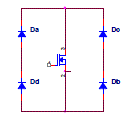 |
| Fig. 2. Conduction of diodes of six topological stages |
| (a) Stage I – 0°to30° (b) Stage II– 30°to60° (c) Stage III – 60° to 90° (d) Stage IV – 90° to 120° (e) Stage V – 120°to150° (f) Stage I – 150°to180° |
| A. Bidirectional Switches |
| When gate circuit is open and Vdd is present, no current flow from drain to source. When gate terminal is made positive with respect to source, current flows from drain to source. The construction of bidirectional switch using four diodes and MOSFET is shown in Fig. 3. |
 |
| During positive half cycle of the input voltage, diodes Da and Db are forward biased. When gate signal is applied with respect to source, the input current flows through Da, MOSFET and Db to the load. |
| During negative half cycle of the input voltage, diodes Dc and Dd are forward biased. When gate signal is applied with respect to source, the input current flows through Dc, MOSFET and Dd to the load. |
| B. PI Current Controller |
| Fig. 4 shows the block diagram of PI current controller. It continuously compares the output current with the reference value and generates the signal to control the conduction of the bidirectional switch. The summing point produces the error signal by comparing the output current and reference value. This error signal is given to the integrator through the gain block to Continuous-time integration of the input signal. The output the integrator and error signal is given to another summing point. The output of summing point is given to the saturation block to limit the input signal to the upper and lower saturation values. |
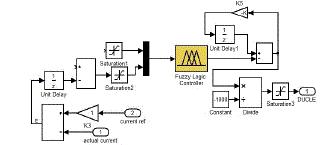 |
| C. Fuzzy Logic Controller |
| The inputs to the fuzzy controller are output current and Error (e) in output current. The output from the fuzzy controller is control signal CS. The fuzzy variables Negative Large (NL), Negative Medium (NM), Negative Small (NS), Zero (Z), Positive Large (PL), Positive Medium (PM) and Positive Small (PS). In the simple block diagram of the Fuzzy Logic control system shown in Fig. 5, the reference current is compared with a output current of diode rectifier, and the difference between the reference current and output current is equal to the error (e). The output current and error are both uses as inputs to the FL controller. The FL controller uses the TSK technique to obtain control signal as its output. The control signal is then fed to the bidirectional switches to modify the conduction period and then input current. |
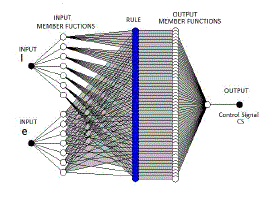 |
| D. Adaptive Neuro-Fuzzy Inference Systems (ANFIS) |
| The objective is to design Adaptive Neuro-Fuzzy Inference Systems (ANFIS) that will improve the input current total harmonic distortion (THD) as well as power factor at the input stage by controlling the conduction period of the bidirectional switches. The ANFIS will use both the output current and output current error of the circuit as input and obtain a control signal as its output. The controls signal will then increase or decrease the conduction period of bidirectional switches that will either achieve the desired power factor at the input stage. The ANFIS Model Structure is shown in Fig. 6. |
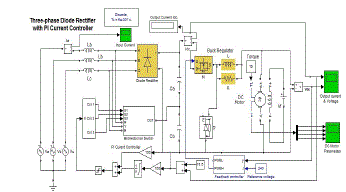 |
SIMULATION RESULTS |
| The closed loop simulation diagram of three phase diode rectifier with bidirectional switch is shown in Fig. 7. |
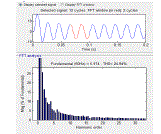 |
| The input current waveform and THD of three phase diode rectifier with bi directional switch is shown in Fig. 8. The THD value of input current is 24.94 %. |
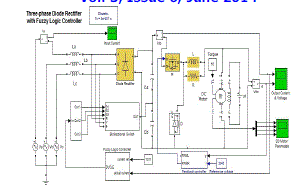 |
| The load test on DC motor with closed loop control was performed and reading was tabulated in the table. III. In this closed control, input current value is increased and therefore input power is also increases gradually. So the performance of the DC motor is improved. |
 |
| The Fuzzy Logic Controller based simulation diagram of three phase diode rectifier is shown in Fig. 9. The input current waveform and THD of three phase diode rectifier with bidirectional switch is shown in Fig. 10. The THD value of input current is improved with 24.20 % when compared with closed loop system of 24.94 %. So the input current waveform is also improved with sinusoidal form. |
 |
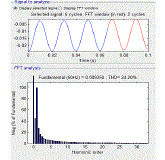 |
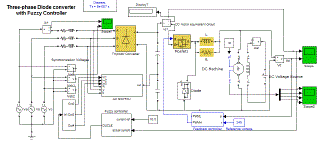 |
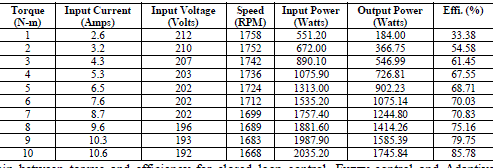 |
CONCLUSION |
| From the results it is evident that three phase diode rectifier with PI controller, Fuzzy Inference System and Adaptive Neuro-Fuzzy Inference Systems have improved performance in terms of input current harmonics distortion (THD), power factor at input and output side, voltage regulation and switching losses. Good performance is exhibited in recognizing the optimal generation of control signal to the bidirectional switches. The technique has been tested for the three phase diode rectifier with various load torque condition of DC motor. The network is trained by different possible combinations of the output current and its corresponding optimal signal is generated for triggering of bidirectional switches. The test results were compared for ANFIS with FLC. The FLC with neural network makes the solution little bit more efficient only by trains the parameters. |
References |
|